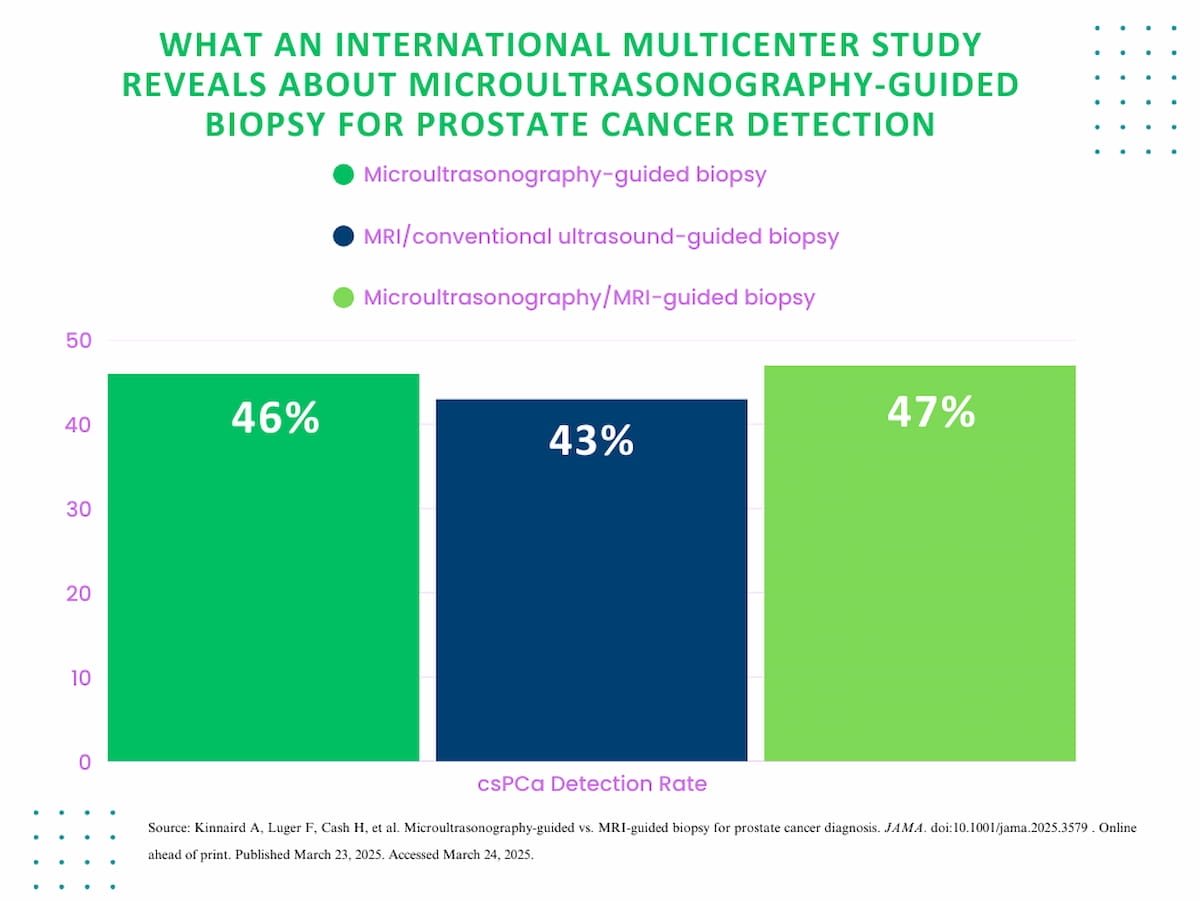Could Microultrasonography-Guided Biopsy be an Alternative to MRI for PCa Detection in Biopsy-Naïve Men?
Microultrasonography-guided biopsy offered comparable detection as MRI/conventional ultrasound-guided biopsy in detection of Gleason grade group 2 or higher prostate cancer, according to a new international multicenter study.
Emerging research suggests there is no significant difference between microultrasonography-guided biopsy and magnetic resonance imaging-guided biopsy for clinically significant prostate cancer (csPCa) detection.
For the international multicenter, phase 3 randomized study, recently published in the Journal of the American Medical Association (JAMA), researchers compared microultrasonography, MRI/conventional ultrasound and microultrasonography/MRI for the guidance of biopsies for detection of Gleason grade group > 2 prostate cancer. The cohort, drawn from 20 centers, was comprised of 678 biopsy-naïve men (median age of 65 with a median prostate-specific antigen (PSA) level of 6.9 ng/mL), according to the study.
The study authors found that microultrasonography-guided biopsy detected csPCa in 46 percent of patients versus 43 percent for patients who had MRI/conventional ultrasound-guided biopsies. The combination of microultrasonography and MRI-guided biopsy led to csPCa detection in 47 percent of patients. There was no statistically significant difference between the biopsy techniques, according to the researchers.
The authors of a new international. multicenter phase 3 trial found no statistically significant difference between microultrasonography-guided biopsy, MRI/conventional ultrasound-guided biopsy and microultrasonography/MRI-guided biopsy in detection of clinically significant prostate cancer (csPCa).

“These findings have significant clinical implications. For patients and physicians, microultrasonography is a novel method of imaging and biopsy with potential greater accessibility for patients considering prostate biopsy, particularly for patients with contraindications to MRI,” wrote lead study author Adam Kinnaird, M.D., Ph.D., who is affiliated with the Division of Urology in the Departments of Surgery and Oncology at the University of Alberta in Edmonton, Canada, and colleagues.
“From a resource perspective, the requirement for 2 procedures (pre-biopsy MRI, usually with gadolinium, and biopsy) becomes a single encounter using microultrasonography with no contrast requirement, thereby reducing wait times, cost, contrast-related morbidity, and patient anxiety.”
The researchers also noted that microultrasonography offers unique advantages in the assessment of prostate cancer (PCa).
“Microultrasonography has an imaging resolution of 70 microns (0.07 mm), providing a 300% improvement in resolution to conventional ultrasonography. The increased resolution of microultrasonography allows real-time visualization of prostate cancer, negating registration error. The 70-micron resolution is equivalent to the diameter of a typical prostate duct, permitting visualization of prostate cancer as malignancy alters the ductal architecture,” noted Kinnaird and colleagues.
The study authors cautioned about a learning curve with microultrasonography, noting that reviewing physicians in the study completed advanced certification training in microultrasonography. They also noted that unlike the PI-RADS scoring system, which has undergone several modifications, the Prostate Risk Identification using Micro-Ultrasound (PRI-MUS) scoring system has only had one iteration thus far.
(Editor’s note: For related content, see “Can MRI-Guided Transurethral Ultrasound Ablation Have an Impact for Localized Prostate Cancer?,” “Can MRI-Based AI Bolster Biopsy Decision-Making in PI-RADS 3 Cases?” and “Study: PET/CT Multivariate Model Enhances Accuracy for Diagnosing Prostate Cancer.”)
In regard to study limitations, the authors acknowledged a lack of blinding with respect to the biopsy technique as well as a lack of standardization of the MRI/ultrasonography fusion device employed at different centers participating in the study. The researchers noted that biopsy was mandated for all study participants despite common clinical practice of avoiding biopsy in men with PI-RADS sores < 3 and favorable PSA levels.
Could Ultrafast MRI Enhance Detection of Malignant Foci for Breast Cancer?
April 10th 2025In a new study involving over 120 women, nearly two-thirds of whom had a family history of breast cancer, ultrafast MRI findings revealed a 5 percent increase in malignancy risk for each second increase in the difference between lesion and background parenchymal enhancement (BPE) time to enhancement (TTE).
MRI Study Suggests Shape of White Matter Hyperintensities May Be Predictive of Cognitive Decline
April 7th 2025Emerging research demonstrated that cognitive declines in memory, executive function and processing speed domains were associated with irregular shape of periventricular/confluent white matter hyperintensities.
Can Abbreviated MRI Have an Impact in Rectal Cancer Staging?
April 4th 2025Abbreviated MRI demonstrated a 95.3 percent specificity for rectal cancer and provided strong agreement with the full MRI protocol for T staging and detection of extramural venous invasion, according to newly published research.